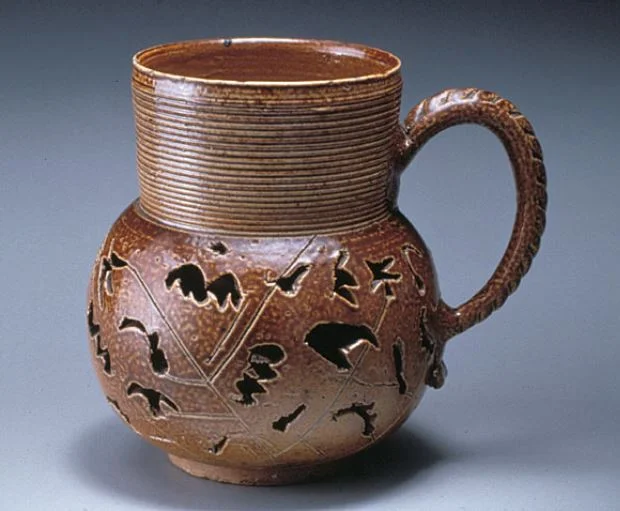Mark Shapiro (MA)
Mark's Statement
I first saw a Morley pierced double-walled stoneware mug in the Delhom Collection at the Mint Museum almost three decades ago. It struck me then and has stuck with me ever since. First, I love this basic cup form: a cylinder atop a globe, wedded with a handle. I’ve seen variations of this iconic form in pre-modern European, Native American, and Islamic ceramics. But there is an extravagance to the pierced double-walled version; the visual and technical complexity of this usually humble pot is undeniable. For a potter to throw two independent and joined walls is a lot of extra work—and yet offers less volume for the drinker. So why the double wall? The handle takes care of any concern that a hot beverage could transfer heat from the inner wall, making the pot uncomfortable and necessitating the second skin. But there is something immensely pleasing about the way the inner container hangs down from the rim of the outer form, suspended but not touching the foot ring. And the double wall makes possible the strangely stylized foliate piercings, a visual play on our expectation of a container’s integrity: this mug has holes and yet is not leaky. The iconography of the Delhom mug’s time-consuming piercings are quirky, somewhere between star and fossil, the curvilinear incised stems mannered.
With appetite whetted by my earlier encounter with one of its cousins, I embraced the chance to respond to the Chipstone Collection’s Morley mug. To my eye, this mug has an even more pleasing shape and proportion. The straighter neck makes the belly feel more globular, which in turn is echoed in the rounded arc of its handle. The piercings while still perhaps vegetal, are even stranger, reading as abstracted landmasses or maybe bats. Where the Delhom mug’s piercings repeat a couple of motifs, the Chipstone mug’s are free and wild, almost doodles, each pierced shape a mark of the potter’s bounding imagination. The incised straight stem lines are also more abstracted and unselfconscious. What a pot!
First, to get to know the historical object, I threw a facsimile of the Morley mug in dark stoneware. A neighbor was taken by it and carried it off to decorate with piercings of his own devising. Then I made a pilsner form in a porcelaneous white stoneware, which I felt had a relation to the fine fabric of the Nottingham mug, but with a brighter graphics quality that I thought would work well in my salt and wood kiln. The taller pilsner seemed more contemporary. I decorated the first one with piercings after the Chipstone mug’s, to get their feel. Then I made some taller double-walled pilsners, which stood on a ware shelf waiting to be pierced.
I had seen Nottingham pots with inscriptions, and in my studio practice, I sometimes write text on my pots that encapsulates cultural or historical moments. So I moved toward that idea for this piece, waiting for the right words to arrive and grab me, and thinking about how to render them.
Around that time, it was reported that Secretary of State Rex Tillerson called President Trump a f—ing moron, after Trump reportedly had astonished his military brass by saying he wanted to retool the nation’s nuclear stockpile up to its peak level of half a century ago—a tenfold increase that would break the international agreements the U.S. has stuck to since the 1980s. In that situation room meeting, he also showed shockingly little understanding of Afghanistan and North Korea. That moment brought home just how weird things had become: the CEO of the biggest fossil fuel corporation in the world becomes secretary of state, with no previous diplomatic or political experience, and finds our nation’s president to be grossly uninformed and incompetent, and is incensed enough to let it slip. Wow.
H.L. Mencken’s quote from a 1920 Baltimore Evening Sun article had started circulating again after the 2016 election. It seemed uncannily prophetic then, but we didn’t know at that time that the muckraking newspaperman’s concluding word would be exactly the one Tillerson, in uncensored frustration, called his boss: "As democracy is perfected, the office of president represents, more and more closely, the inner soul of the people. On some great and glorious day, the plain folks of the land will reach their heart's desire at last and the White House will be adorned by a downright moron."
Laying out the text and cutting the letters was laborious. I’ve never been much for penmanship, but I let that go and went at the clay with an X-Acto knife for the first letters of each word (along with a drill to get the round letters started), and scrawled in the rest of the text. Piercing just the first letters gave a random overall feeling.
Taking this cup out of the kiln, I was pleased by its amber interior against the salted orange-peel textured grey of its exterior. I hope my pilsner will be interesting to drink from. Texts that revolve around a pot invite the user to rotate it, contemplating, slowly rendering the words comprehensible. As Mencken’s prophesy moves around your field of vision, from the table to your hand, and up your mouth to take that first sip, I’d imagine you might well need that drink... and perhaps another.

Downright Moron (After H.L. Mencken, 1920 and the Morley Family, c. 1700)
Mark Shapiro, 2017. Worthington, MA. H. 7¾”
This is the historical piece Mark created for THE LAST DROP: INTOXICATING POTTERY, PAST AND PRESENT.

Carved or Double-Walled Mug
Nottingham, England, ca. 1700. Salt-glazed stoneware. Chipstone Foundation. 1964.43. H. 3 ¾”
This is the historical piece from which Mark chose to draw inspiration.
